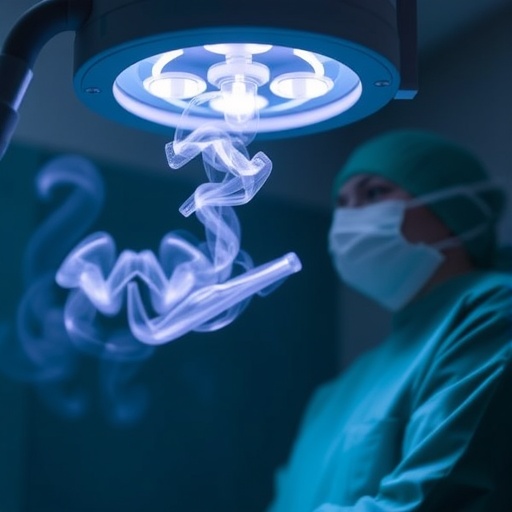
In the realm of minimally invasive surgery, maintaining a clear visual field is paramount for surgical precision and safety. A significant obstacle compromising this clarity is the production of surgical smoke during tissue dissection. This smoke not only clouds the laparoscopic environment, impairing the surgeon’s view, but also carries particulate matter (PM) that poses health risks to the operating room staff. Addressing this dual challenge, researchers have innovatively harnessed nebulization technology to enhance the clearance of laparoscopic surgical smoke, marking a pivotal advancement in surgical engineering and occupational safety.
Surgical smoke is an unavoidable byproduct generated by energy-based surgical instruments such as electrocautery devices and ultrasonic scalpels. These instruments vaporize tissue, producing plumes laden with particulate matter of various sizes. Among these, fine particles—measured as PM1.0, PM2.5, and PM10—are particularly concerning due to their ability to penetrate deep into the respiratory tract and their potential to carry viable biological materials. Beyond visibility issues, prolonged exposure to these aerosols threatens operating room personnel with respiratory and other health complications.
Traditional methods to manage surgical smoke involve mechanical suction or evacuation systems that aim to remove smoke from the surgical site. However, these systems can sometimes disrupt the pneumoperitoneum essential for laparoscopic surgeries or inadequately clear finer particles, thereby only partially addressing the problem. To overcome these limitations, the research team led by Lin et al. evaluated an emerging approach—nebulization—for efficient and rapid surgical smoke clearance.
Nebulization, commonly employed in respiratory therapies, involves generating a fine mist consisting of micron-sized droplets. This technique promotes the aggregation and deposition of airborne particulate matter, thereby facilitating the removal of suspended particles from enclosed environments. The researchers ingeniously repurposed nebulization within the confined laparoscopic cavity to reduce particulate concentration without compromising the surgical field or patient safety.
In their experimental framework, the team designed and characterized a novel nebulizer capable of delivering a spray cone with an angle of approximately 70 degrees and producing aerosolized particles with a median size near 25 micrometers. This device was tested in vivo using a rabbit model, simulating surgical scenarios with electrocautery hooks and ultrasonic scalpels operating on various tissue types. The study assessed particulate pollution before and after the application of nebulization, comparing its effectiveness against conventional elimination techniques.
Quantitative analyses revealed that the electrocautery hook generated significantly higher levels of particulate matter relative to the ultrasonic scalpel. Furthermore, particulate emissions from the electrocautery device varied notably depending on the tissue type engaged, indicating a complex interplay between instrument mechanics and tissue properties influencing smoke generation. Interestingly, the ultrasonic scalpel’s PM emission exhibited a narrower variation, with only PM1.0 levels showing significant tissue-dependent differences.
Critically, nebulization achieved surgical smoke clearance within 8 seconds, swiftly restoring unobstructed laparoscopic visibility. This rapid dissipation is noteworthy, considering that conventional evacuation methods often struggle with delayed or incomplete smoke removal, adversely affecting surgical efficiency. Importantly, nebulization demonstrated a statistically significant advantage in reducing the concentration of PM1.0 particles compared to elimination alone, underscoring its heightened efficacy in mitigating the most hazardous fine particulates.
Post-treatment assessments further confirmed that nebulization consistently resulted in lower particulate concentrations across multiple tissue types, except for the omentum, where particle reduction mirrored elimination methods. This exception warrants further investigation to comprehend tissue-specific factors that may influence nebulization efficiency or smoke characteristics. Nonetheless, the overarching trend supports the utility of nebulization in enhancing intraoperative air quality.
Beyond visual enhancements, the implications of these findings extend to occupational health. Surgical smoke has long been recognized as a biohazard, containing toxic gases, carcinogens, and viable viral particles capable of causing infection. By efficiently reducing particulate matter, nebulization potentially diminishes these risks, contributing to safer working environments for surgeons, anesthesiologists, and nursing staff.
Integrating nebulization into laparoscopic workflows also presents operational advantages. The non-invasive nature of the technology and its compatibility with existing surgical instruments facilitate seamless adoption without necessitating significant procedural modifications. Moreover, the relatively straightforward design of the nebulizer device may promote affordability and accessibility, making it feasible to implement across diverse healthcare settings.
While this study presents compelling evidence supporting nebulization, the authors acknowledge the need for further research to optimize device parameters, evaluate long-term outcomes, and confirm safety profiles in human clinical trials. Considerations such as the potential impact of injected moisture on laparoscopy insufflation pressures and sterilization protocols will be vital to address prior to widespread clinical deployment.
In summary, the novel application of nebulization technology signifies a transformative approach to managing laparoscopic surgical smoke. By enabling rapid and effective clearance of harmful particulate matter, this innovation enhances surgical visibility and protects operating room personnel from health hazards. The convergence of biomedical engineering and surgical practice epitomized in this advancement embodies a forward leap toward safer, more efficient minimally invasive procedures.
As surgical technology continues to evolve, the incorporation of multidisciplinary strategies such as nebulization exemplifies how patient care and occupational safety challenges can be surmounted through engineering ingenuity. This pioneering research not only sets the stage for improved procedural outcomes but also underscores the critical importance of environmental management in health care environments.
The broader impact of this work may extend beyond laparoscopic surgery, suggesting potential applications in other surgical disciplines and enclosed operative fields where smoke management remains a persistent challenge. Future exploration into the adaptability and scalability of nebulization could herald a new paradigm in surgical air quality control, resonating across the medical community globally.
—
Subject of Research: Use of nebulization technology for efficient clearance of surgical smoke in laparoscopic procedures to improve visibility and reduce particulate matter exposure.
Article Title: Enhancing laparoscopic visibility: efficient surgical smoke clearance innovatively using nebulization technology
Article References: Lin, X., Fan, Q., Li, R. et al. Enhancing laparoscopic visibility: efficient surgical smoke clearance innovatively using nebulization technology. BioMed Eng OnLine 24, 65 (2025). https://doi.org/10.1186/s12938-025-01395-4
Image Credits: AI Generated
DOI: https://doi.org/10.1186/s12938-025-01395-4
Tags: advancements in surgical engineeringenhancing visibility in laparoscopic procedureshealth risks of surgical smokeinnovations in surgical smoke managementlaparoscopic surgery safetyminimally invasive surgical techniquesnebulization technology in surgeryoperating room occupational safetyparticulate matter in surgical smokerespiratory health in surgerysmoke evacuation systems in surgerysurgical smoke clearance



